Protests, rallies and demonstrations have engulfed Iran since Thursday. Beginning on a relatively small scale in the provincial city of Mashhad in Eastern Iran, where a thousand protesters voiced their grievances over their dire economic situation, the demonstrations quickly spread to a number of provincial towns. By December 30th, this oppositional sentiment had arrived in Tehran, the Iranian capital.
At the time of writing (Sunday December 31st), protests have sprouted up in more than 30 towns and cities in – something that has surprised both the Islamic regime itself and analysts inside and outside of the country. For although dispersed protests and small-scale strikes against Iran’s spiralling inflation, huge unemployment and the lack of payment of wages and pensions have been a rather common occurrence during the past few months, the rapid growth and radicalisation of the recent protests has created scenes which we have not witnessed since the mass mobilisations in the wake of the contested presidential election in 2009.
Although it is far too early to provide a comprehensive analysis of the ongoing events, it is evident that thus far the focal point of the unrests has been economic in nature. Alongside the above-mentioned economic problems, there has recently been a significant rise in the price of basic daily goods, which has exacerbated the gulf between the rich and poor. Calling for support for the movement, the Iranian labour movement leader Jafar Azimzadeh argued that, given the terrible social conditions faced by most Iranians, there is a certain inevitability to what we are currently witness: the toxic combination of neo-liberal privatisation and Islamic corruption is exacting a heavy toll.
The growing inequality in Iran is becoming evident not only to the working classes of the towns and cities (particularly those living in the harsher conditions in the provincial regions inhabited by a variety of national and ethnic minorities), but to the lower sections of the urban middle classes as well. All appear to be outraged by the Iranian state’s seeming refusal to do anything to address their plight. It is for this reason that, as the protests continue, their focus appears to be moving beyond economics. Protest slogans such as ‘Bread, Work, Freedom!’, Capitalist Clergy: Give us Back our Wealth!’, ‘The Unpaid Wages of the Retired are Hidden under the Clergy’s Cape’ or ‘The Supreme Leader is living like a God, Whilst the People are Begging’ highlight how the protesters are laying the blame for their economic plight squarely at the feet of the Islamic Regime. And despite the claims of almost all reports in the mainstream press outside of Iran, such oppositional energy is clearly aimed at the IRI (Islamic republic of Iran) state as a whole, not one or other of its ‘principalist’ or the so-called ‘reformist’ factions.
For although Iran’s Supreme Leader, Ayatollah Khamenei, is, by some margin, the biggest symbolic target of the demonstrations, there have been slogans and placards directed against the current (purportedly ‘progressive’) President Hassan Rouhani, the heads of the Iranian parliament, the judiciary and also some of the financially dubious and institutions which are closely tied to the state. The state’s foreign policy has come in for much criticism too.
And the defiance has not been limited to rallies, slogans, chants and pulling down public portrayals of the Supreme Leader either. In a demonstration at Tehran University, for example, female protesters reportedly removed their headscarves in public. Indeed, one of the most iconic images of the bravery and defiance shown by the protests thus far is of one such unveiled young woman standing on top of a statue on one of Tehran’s busiest crossroads, waving her headscarf above her head as the crowds pass by (she has since been arrested).
2017 and 2009
It is tempting to compare the current movement to the 2009 protests, or even to view the ongoing protests as the continuation of the 2009 events. Regardless of what lies ahead in the coming days and weeks, I believe that the current protest movement is already exhibiting several characteristics which are fundamentally different to those of the 2009 Green Movement.
This movement began when Mahmoud Ahmadinejad was declared the president of Iran against his pro-reformist rival, Mir-Hossein Mousavi. As a result, many people in Tehran, and other major cities, took to the streets and thereby initiated something which, in terms of numbers, was the biggest revolt in Iran since the revolution of 1979. This mass mobilisation was certainly not devoid of radicalism, especially during its later stages, but from the outset it was very much in the control of the disgruntled reformist faction, who were mainly concerned with the disputed election results and whose overriding focus was to oust Ahmadinejad. Accordingly, many of the protests were characterised by Shia’ symbolism and religious rhetoric, which became particularly evident in their chants and slogans. The kind of universal economic demands which are so forthright today were utterly marginal back then.
And while the numbers mobilised in 2009 were truly impressive, with the majority of the protests taking place in the capital. Indeed, aside from the misleadership of the reformists, one of the reasons why the Green Movement petered out so quickly was the minimal involvement of the Iranian working classes – particularly those from smaller cities, the provinces and the ethnic minorities, who felt alienated from it.
For the reasons discussed above, the ongoing events, while still in embryo, already show signs of taking on a different direction than in 2009. As we have seen, the impetus for what is unfolding now came not from Tehran, but from working working-class neighbourhoods and provincial towns and cities. The placards, chants and slogans we are currently seeing on social media differ from those of the Green Movement in both form and content.
The response of both fractions of the IRI further underlines the point regarding the contrast between the 2009 and 2017. Initially, both the ‘principalists’ and ‘reformists’ adopted a rather ambivalent stance, watching and waiting to see whether they could exploit the situation to their own factional advantage. But it soon dawned on them that the protests were uncontrollable and were assuming a significant anti-regime dynamic. Unsurprisingly therefore, both factions have quickly found common ground in calling for the protests to be suppressed.
The state has resorted to extreme violence, hundreds have been arrested, assaulted, beaten and shot. Internet access has been heavily restricted, as has access to social media and the popular mobile-phone messaging service Telegram. At least two campaigners have been shot dead in the Western town of Dourd. All the while, both fractions of the regime (and their acolytes outside of the country) are stepping up the propaganda war to undermine the protestors – desperately trying to pass the movement off as Western-led, Zionist-imperialist conspiracy.
It is too early to say with certainty whether the protests will be able to last, whether or not they will be able to withstand the violence of the Iranian state’s repression. But what is undeniable is that the past few days represent a spark of hope for genuine and fundamental change from below, beyond the existing fractions of the IRI, which can only take the form of a fundamental political upheaval.
At this time, creating international support for the cause of the Iranian people and raising awareness about the emerging movement is crucial – and it could help to counter the efforts of the IRI and its supporters in seeking to undermine the movement and its ramifications.
Moreover, in seeking to spread the inspiring message of the Iranian people internationally, it should be stressed that the meddling of foreign powers such as the Trump administration in the USA (which has no credibility among the majority of the people) cannot be of any help to the protests. Such hypocritical intrusion can only make things worse for the burgeoning movements, providing a pretext for the Iranian state to crackdown on all opposition all the more ruthlessly. There is a lot to play for – and it is encouraging to see that, in spite of everything that this brutal state throws at its people, the very best traditions of Iranian radicalism and bravery have not gone away.

Anahita Hosseini 31.12.2017
